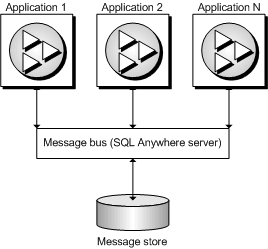Application-to-application messaging consists of applications transmitting messages via a SQL Anywhere database acting as a local message store. The messages are transmitted between applications through their connection to the database. The following diagram illustrates a typical scenario where two applications use a local message store to transmit messages between them.

This setup includes the following components:
Local message store Messages are stored in the SQL Anywhere database. The database must be set up as a local message store.
QAnywhere Agent The QAnywhere Agent manages the transmission of messages. This process is independent of QAnywhere applications.
QAnywhere application An application written using the QAnywhere C++, Java, or .NET API makes method calls to send and receive messages. The basic object used by the client application is the QAManager.
Messages are sent and received by QAnywhere applications connected to the SQL Anywhere database. Messages are not picked up until an application initiates a message transmission. QAnywhere applications use policies to determine when to perform a message transmission. Policies include on-demand, automatic, scheduled, and custom. The on-demand policy permits the user to control message transmission. The automatic policy initiates a message transmission whenever a message to or from the client is ready for delivery. The custom policy uses transmission rules to add further control over message transmission.
 See also
See also |
Discuss this page in DocCommentXchange.
|
Copyright © 2012, iAnywhere Solutions, Inc. - SQL Anywhere 12.0.1 |